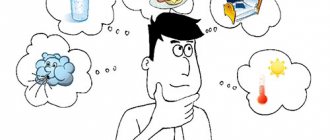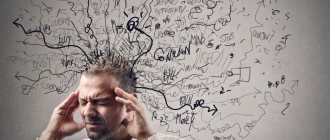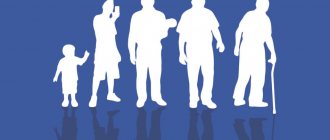Brief Definition
A need is a need for something that motivates a person to take action to satisfy it.
Subjectively, it is felt as discomfort, tension, “internal itching.” At the moment of satisfaction, these unpleasant sensations are replaced by a feeling of pleasure and relaxation, which serve as a reward to the person for his efforts.
A person constantly experiences several needs. To ensure normal life, we need food, water, fresh air, comfortable living conditions, etc. These needs are basic, primary. Failure to satisfy them leads to serious health problems and even death.
There is another group - secondary. They arise only when a person’s basic needs are “closed.” These include spiritual, social and existential needs. We will talk about them in more detail when we consider A. Maslow’s pyramid.
Needs can be conscious or unconscious. Conscious ones turn into motives and determine human activity. The unconscious is hidden in the subconscious and sometimes breaks out in the form of strong emotions.
Highest human needs
Attention! If the high needs and values that I am now writing to you seem insignificant, then know this! You are controlled by low needs and their cult does not allow you to see what people see who achieve their goals. How did you even get onto this blog? How did your perception reach these lines?
The very first thing a person with higher needs experiences is contempt for lower needs. A person simply underestimates what others cultivate. For him, sex is like food - go and get it. Security prevents you from moving forward, and asserting yourself at the expense of others is a waste of time.
When I have a lot of sex, a lot of food and I am recognized in society, then for me it becomes not only natural, but also banal and even boring.
And then we want to achieve higher needs.
The highest need for love.
It is in love, not in sex. Where love is not contemplation and stupid admiration, but real action. And this action is expressed in giving more than taking. That is, sacrificing yourself, your time, money for the sake of the happiness of another person or the happiness of other people.
The highest need to create.
Most people are users. Moreover, users enjoy it and, if they’re lucky, get it for free. But a person with higher needs gets a thrill from creating, and not from using. Some people use music, and some people create it. Someone buys the products, and someone creates and packages them. Some people read books, and some people write them. And so on.
No matter what. Business or family. Scientific discovery or art. The highest need to create and thinking begins to spin in this direction - to search and think in order to create something like this, to give it to the world. Call it what you want.
The highest need to grow above oneself.
Be higher today than you were yesterday. Above yourself, not others! This is how great athletes, composers, writers and artists are born. And just effective people.
Characteristics of needs
Needs have a number of characteristics and are subject to certain laws:
- At birth, a person is characterized only by physiological needs, the rest develop later.
- The lower needs are characteristic of all people equally.
- The higher ones differ greatly from person to person and form an individual portrait of the individual.
- Satisfaction of lower needs opens the possibility for the formation of higher ones, but does not guarantee it.
- The higher the need, the less important it is for survival and the longer it may remain unsatisfied.
- The more a person is involved in various activities, the more complex his system of needs.
- Suppression has a negative impact on psychological and physiological well-being and deforms the personality.
- The occurrence and satisfaction are associated with various emotions.
- A person's focus is fixed on the subject of need and causes attention to flow in its direction.
More than 100 cool lessons, tests and exercises for brain development
Start developing
What are the differences?
But first, a few words about how lower and higher needs differ and how we can try to classify them. Without further ado, let us turn to the hierarchy of the system of human needs, the so-called pyramid, which was proposed by the American psychologist Abraham Maslow. Here you can clearly see how lower and higher needs differ and what types of steps exist. At the base of the imaginary pyramid are the physiological (so-called lower) ones. Then - the need for safety, love, respect. After that are the needs associated with cognition. Aesthetic, artistic. And finally, at the imaginary peak - self-actualization, that is, personal development and realization of abilities and goals set for oneself, finding meaning in life and a place in human society. What is the difference between lower and higher human needs? Let's take a closer look.
What are the needs?
There are several approaches to classification. Almost all eminent psychologists involved in research on this issue divided them into higher and lower. We have already examined this differentiation a little higher.
A more complex classification divides needs into three types:
- Biological (bodily). All needs related to physiology.
- Social. Needs that are determined by the social nature of man.
- Existential. They introduce a person to the eternal. Creativity, self-improvement, knowledge.
Biological
Biological needs are literally built into humans. There is no way to get around them. These include:
- suitable food;
- comfortable environmental parameters;
- water suitable for drinking;
- normal ecology;
- safe housing;
- disposal of waste products;
- sexual satisfaction.
This basic list has remained virtually unchanged since the creation of man. But the quality of needs has changed significantly. Today, a person can no longer be content with raw meat, clothing made from skins and a hut made of branches. The level of comfort has increased over thousands of years and will continue to increase.
The balance of basic needs changes throughout life. For example, sleep is more important in the early years of life than in adulthood. Sex, being a priority in adolescence, fades into the background after 40 years.
Social
They reflect the social nature of man. Here we include:
- sense of belonging to society;
- social interaction;
- feeling of affection;
- self-affirmation;
- recognition of merit.
A person can live without satisfying these needs, but his life will be incomplete.
Existential (spiritual)
This group of needs comes from a system of universal human spiritual values, from ideas about beauty, about good and evil, about harmony, about communion with the eternal. Not all people have such needs, since they are at the very top of the hierarchy.
Existential needs include:
- hunger for knowledge;
- desire for self-improvement;
- craving for creativity;
- search for the meaning of life;
- introduction to beauty.
A person must strive throughout his life to reach this level and firmly establish himself on it.
What is the essence of the hierarchy of needs?
Maslow suggested that human needs are distributed according to levels - from the simplest to the highest. At the same time, the desire to satisfy elevated needs arises when we satisfy the lower ones.
Let's imagine that a person needs food and shelter. It is unlikely that he spends much effort on developing any of his abilities. His thoughts and efforts are focused on eating and finding shelter. But if a person has already provided himself with food and accommodation, then he becomes motivated to start a family and achieve success at work.
And when everything is there - a comfortable home, a decent job, a good family, recognition in society - a person can think about realizing his lofty needs. For example, he worked as an engineer all his life, but dreamed of learning to draw or play the guitar. And the person begins to satisfy these sublime needs.
Maslow explained his theory in more detail in 1954 in his work “Motivation and Personality.” He described the sequence of needs by level:
- Physiology. At the very first level, a person needs food, rest and satisfaction of other needs that are necessary for the normal existence of the body.
- Safety. Here there is a desire for stability, protection from external threats.
- Love and belonging. This level assumes that a person satisfies social needs. For example, he finds friends, creates a family, makes acquaintances with interesting people.
- Respect and recognition. At this stage, there is a need for recognition from society. For example, you want to achieve high status, earn the respect of others, and receive confirmation of your merits.
- Self-actualization. Upon reaching this level, a person has a desire to fulfill his spiritual needs. This could be the development of talents, the search for the meaning of life.
The goal of human behavior according to Maslow's theory is to reach the fifth level: self-actualization. In later works, the psychologist added two more levels to self-actualization: cognitive abilities and aesthetic needs.
Life cycle
Let's look at how a need arises, develops and is realized. At the initial stage, it is felt as a vaguely realized and unformed need for something. It acts as an internal hidden condition for activity, in the form of a certain ideal.
Next, the need is objectified and specified, acquires details and becomes the driving force of human activity. For example, an individual discovers a craving for love and begins to look for a partner for a relationship.
Motives are born from needs, which are subsequently transformed into goals. The totality of all motives forms the orientation of the individual.
The longer the need remains unfulfilled, the stronger the internal tension and discomfort. It forces attention to flow towards the object and encourages a person to take active actions.
If you are very hungry, then your attention will snatch images associated with food from the surrounding reality.
At the moment of realization, a person experiences emotional release and a feeling of satisfaction from the achieved goal. There is a release of joy hormones - serotonin and endorphin. This is a kind of reward for the work done and encouragement for new achievements.
Naturally, not every need is realized. Failure to implement this can lead to the following consequences:
- Death of a person. When it comes to basic biological needs.
- Frustration. This is a strong experience due to the unsatisfaction of the most important need for a person, bordering on a nervous breakdown.
- Sublimation. This is the transformation of feelings of dissatisfaction into creative energy.
All of the above means that a person should be attentive to his inner impulses: be aware of, accept and not try to suppress them. This is a necessary condition for the psychological health of the individual.
Lowest platform
Physiological needs can be satisfied throughout your life and never be satisfied. Pathology and displacement of value orientations, as a rule, occur in many members of modern society (regardless of wealth and social significance). And all these problems are due to the exaltation and highlighting of lower needs. This is how dissatisfaction with oneself and one’s life, destiny, and place in society comes. Lack of understanding of your role in life. The result is a low social role, a feeling that you are a cog in a machine, a piece of gray mass, causing oppression and a feeling of hopelessness.
Theories of needs in psychology
Let's look at several theories of famous psychologists who studied this phenomenon.
Abraham Maslow's theory
The most famous theory of the formation and development of needs belongs to the American psychologist, founder of humanistic psychology A. Maslow. According to it, human needs form a clear hierarchical structure consisting of 5 elements. The author himself depicted this structure in the form of a pyramid divided into horizontal sectors.
At the base of the pyramid are needs, the satisfaction of which is vital for a person. The higher the level, the less significant and critical they are. Let's take a closer look at the structure, starting from the bottom level:
- Physiological needs. This includes the need for food, water, natural needs, sleep, and satisfaction of sexual desires. They ensure the normal functioning of the individual at the biological level.
- Safety. This is the need for stability, confidence in the future, maintaining health, etc.
- Socialization and love. It is important for a person to feel that he belongs to society and to establish social connections. This includes the need for attention, affection, and communication.
- Confession. The desire to achieve respect in society and satisfy vain ambitions.
- Self-actualization. The desire to realize the potential inherent in a person to 100%.
The first two levels contain the lowest needs. They are innate and must be satisfied first. The three upper levels contain the so-called higher needs, formed under the influence of the social environment.
Unsatisfied lower levels block the emergence of higher ones. A person must move from the bottom up the pyramid and strive to reach the highest level.
It is the hierarchy of Maslow's theory that is most often criticized. There are many examples that contradict it. For example, how to explain the exploits of soldiers who fought in the name of the Motherland, being hungry or deprived of basic amenities. But nevertheless, at the moment this is the most perfect and advanced theory.
We have a separate article on Maslow’s pyramid on our blog. Take a look there.
Clayton Alderfer's theory
American psychologist Clayton Alderfer slightly modified A. Maslow’s theory, identifying 3 groups:
- Existence needs. The first two stages of Maslow's pyramid are combined here. Alderfer considered them needs of the same order.
- Communication needs. What in Maslow's theory is called the need for socialization and love.
- Growth needs. Learning and striving for inner progress.
Unlike Maslow, Alderfer did not believe that a person moves strictly from lower to higher needs. The dynamics of movement may vary depending on the circumstances.
Take a look at our article about what self-realization is.
David McClelland's theory
American psychologist David McClelland focused his attention on higher needs. He studied the motives that make a person develop in various activities and strive to dominate other people.
McClelland identified three basic needs that develop in a person throughout life:
- In achieving or accomplishing.
- In interaction.
- In power.
However, there is no clear hierarchy between them. Different people may have different needs overriding them. This is determined by individual characteristics and parenting style in childhood.
Erich Fromm's theory
The representative of neo-Freudianism, Erich Fromm, studied the role of the unconscious in the process of formation of needs.
According to his concept, the entire experience of humanity is imprinted in the unconscious, as well as the hidden potential of the individual, which was initially allocated to a person. However, when faced with rigid boundaries and stereotypes of the real world, an internal conflict arises. So many needs remain unfulfilled.
Fromm identified the following needs:
- communication and establishing social connections;
- creation;
- belonging to a clan, a sense of deep roots;
- identification with someone or something;
- cognition.
Practical application of Maslow's theory of needs
Where and how is Maslow's theory of needs applied? In fact, psychological theory is applicable to many issues related to or based on human needs and motivation. It is implemented in marketing, management, psychology, in the process of self-analysis, for example.
- Marketing
In the process of promoting a product, a marketer needs to analyze the product being sold, determine its central audience and, in turn, study it. The next step is to figure out how to present the product to this buyer. At most stages, understanding a person's needs can be key. Both the needs themselves and the mechanisms and nature of human motivation allow us to form an idea of the needs and goals of people, as well as how to convince them to purchase a product.
Practical application of Maslow's theory of needsExamples can be given regarding different levels of needs. Basic needs - food and water - are realized in advertising of available products or establishments, when the emphasis is on nutrition and price. In premium product marketing, the analysis clearly addresses recognition needs, and so on.
Moreover, Maslow's theory allows you to plan a change in thinking and, accordingly, the goals and needs of the audience that remains with the brand. The mechanism and nature of needs, as well as the distribution in the hierarchy itself, is an excellent tool for analyzing the needs of the audience and the dynamics of their change over a certain period of time.
However, it is necessary to understand that using Maslow’s theory as the only tool is pointless. A good marketer uses a range of methods and resources, and Maslow's theory of needs is only one of them, although quite useful in certain conditions.
- Management
A manager interested in high productivity indicators of his employees must understand what and how motivates employees. Some managers use only economic incentives, while the theory of an American psychologist can be a very useful tool for analyzing audiences. Understanding the nature of employee motivation and the immediate goals and needs of this employee allows you to interest the employee in work.
Goods and anti-goods
A benefit is something that people use to satisfy their needs; it can be food, clothing, a car, in general, something that a certain person wants or needs.
Anything can be a blessing, the weather, if a person likes it, or even his favorite music or song.
Figure 2.
Finished works on a similar topic
Coursework Requirements 450 ₽ Abstract Requirements 260 ₽ Examination Requirements 200 ₽
Receive completed work or specialist advice on your educational project Find out the cost
And, of course, let’s not forget about Anti-Blaks We have already completed a report
Anti-benefits. more details
Anti-goods are something that a person does not want to consume or use because it will make him feel bad. For example, you can name mosquitoes or rain if a person does not like it. As we can see from the picture, some anti-goods can even be fatal to humans, such as poison or wild animals, predators. It can also be said that the absence of these anti-goods, which are fatal, is a good of prime necessity.
Some goods are mandatory for life, others are needed only because a person wants something, although he does not really need it. So why does a person consume those benefits that he, in principle, do not need? Because he gets a certain pleasure from using them.
Now let's move on to the structure of human needs.
Holistic-dynamic theory of personality by A. Maslow
Holistic-dynamic theory of personality by A. Maslow
Either you take a step forward towards personal growth, or you take a step back into safety.
Abraham Maslow's (Abram Samuilovich Maslov) personality theory has been variously called humanistic theory, transpersonal theory, the third force in psychology (the first force is psychoanalysis and its modifications. The second force is behaviorism and its modifications), the theory of needs and the theory of self-actualization. However, Maslow himself called the theory holistic-dynamic because it assumes that a person is constantly motivated by one need or another and that people have the potential to grow towards achieving full self-actualization. To achieve self-actualization, people must satisfy lower-level needs such as hunger, security, love, and esteem. Only after they have been relatively satisfied in each of these needs can they achieve self-actualization in the higher level needs.
A. Maslow criticized both psychoanalysis and behaviorism for their limited views of human nature and their inadequate understanding of the psychologically healthy person. Maslow believed that people have a higher nature than psychoanalysis or behaviorism described.
Maslow's personality theory is based on several basic assumptions:
- First, it is a holistic approach to motivation: the whole person, and not some separate part or function, is motivated.
- Second, motivation is typically complex, meaning that a person's behavior may stem from several distinct motives. For example, the desire for sexual intercourse may be motivated not only by the Freudian psychosexual genital need, but also by the need for dominance, communication, love and self-esteem. Moreover, the motivation for behavior may be unconscious or unknown to the person. For example, a college student's motivation to achieve a high grade may mask a need for dominance or power. Maslow's recognition of the importance of unconscious motivation is one important aspect. Any action, in addition to obvious and conscious motivation, may have other hidden and underlying motives.
- The third assumption is that people are constantly motivated by some need or another. When one need is satisfied, it usually loses its motivational power and is then replaced by another need. For example, as long as people's needs for food remain unsatisfied, they will strive to obtain it. But once they have enough food, they move on to satisfy higher-order needs, such as the needs for safety, friendship and self-esteem.
- The fourth assumption of the theory is that all people around the world are motivated by the same basic needs. The ways in which people in different cultures obtain food, build homes and relationships may vary widely, but basic needs such as food, safety and friendship are common to all humanity.
- A final assumption regarding motivation is that needs can be organized into a hierarchy, with basic physiological needs at the bottom and self-actualization needs at the top.
Nature of motivating needs
Maslow hypothesized that some human needs are initially determined by instincts, but can be changed through learning. Sex, for example, is primarily a physiological need as part of the reproductive instinct, but the way in which this need is expressed depends on learning.
One of the criteria for separating instinctive (instinctoid) needs from non-instinctive ones is the level of violations when they are dissatisfied. Suppression of instinctual needs leads to the development of pathology, while frustration of non-instinctoid needs does not produce such a negative effect. For example, when people are denied enough love, they get sick, just as when they lack food or a safe environment.
The second criterion for distinguishing between instinctoid and non-instinctoid needs is that instinctoid needs are persistent and their satisfaction is necessary to maintain mental health. Non-instinctoid needs, on the contrary, are usually temporary in nature, and their satisfaction is not a prerequisite for health.
The third difference is that instinctoid needs are species specific. Therefore, animal instincts cannot be used as a model for studying human motivation. For example, only a person can be motivated by self-esteem and self-actualization.
Fourth, although instinctual needs are difficult to change, they can be shaped, suppressed, or changed by environmental influences. Many instinctoid needs (for example, love) are weaker than the external forces of society (for example, aggression in the form of crime or war). Therefore, Maslow insisted that society must “protect the weak, subtle and gentle instinctual needs so that they are not suppressed by the harsher and more powerful culture.” In other words, instinctoid needs can be changed and even destroyed by more powerful forces of nature and civilization. Therefore, a healthy society must seek ways in which its members can receive satisfaction not only of physiological and safety needs, but also of love, respect, and self-actualization needs.
Lower and higher needs
Important similarities and differences exist between higher-level needs (love, esteem, self-actualization) and lower-level needs (physiological and safety). Higher needs are similar to lower ones in that they are also instinctoid. Maslow insisted that love, self-esteem and self-actualization are as biological as thirst, hunger and sex and love. The differences between higher and lower needs lie on a different plane.
First, higher level needs are found later at the phylogenetic or evolutionary level. For example, only humans (a relatively recent biological species) have the need for self-actualization. In addition, higher needs appear later in the course of individual development. Lower needs must be unconditionally met in infants and children so that they can progress to higher levels of needs.
Second, satisfying higher-order needs gives people greater feelings of happiness and more peak experiences. Peak experiences are a term coined by Maslow to describe sudden intense feelings of happiness, fullness of existence, which are often also accompanied by a feeling of unity with the world, nature, other people, works of art, awareness of some “absolute truth”, the unity of all things. Hedonic pleasure generated by the satisfaction of lower needs is usually temporary and incomparable with the quality and level of happiness experienced when higher needs are satisfied. In addition, satisfaction of a higher level of needs is more subjectively desirable for those people who have experienced both higher and lower level needs. In other words, a person who has reached the level of self-actualization will not have the motivation to return to a lower stage of development.
The concept of hierarchy of motives
Maslow's hierarchy of needs suggests that lower-level needs must be satisfied, or at least partially satisfied, before higher-level needs can become effective regulators of behavior. These needs are in a hierarchy (pyramid or ladder), where each subsequent level reflects more spiritual (higher) and less and less necessary needs for survival. For example, someone to be motivated by self-esteem or self-actualization must satisfy their needs for food and security in advance. Satisfaction of physiological needs is a priority for survival. Maslow listed the needs in order of their predominance: physiological needs, safety needs, love and belonging needs, esteem needs and self-actualization needs. Maslow calculated that the hypothetical average person would have satisfaction in their needs to approximately the following levels:
- Physiological - 85%
- Safety - 70%
- Love and belonging - 50%
- Self-esteem - 40%
- Self-actualization -10%.
The more a need at a lower level is satisfied, the greater the need at the next level arises. The quantitative ratio of the expression of needs is graphically successfully displayed in the form of a layer pyramid. For example, if love needs are only 10% satisfied, then esteem needs may not appear at all. But if the needs for love are satisfied by 25%, then the need for respect can develop by 5%. If love is satisfied to 75%, then the need for respect expands to 50%, and so on. Therefore, needs arise gradually, and a person can be simultaneously motivated by needs from two or more levels.
For example, a self-actualizing creative person may be the guest of honor at a dinner given to him by close friends in a quiet, cozy restaurant. The act of eating satisfies a physiological need, but at the same time the guest of honor may be satisfied by security, love, respect and self-actualization needs.
Although the basic hierarchy of needs is the most common, sometimes 10.1, sometimes needs can be reversed. For some people, the desire for self-esteem or creativity (the need for self-actualization) may take precedence over safety and physiological needs. An enthusiastic artist may risk safety and health to complete important work. A person who considers human dignity and universal humanistic values to be an absolute is capable of opposing the superior forces of totalitarian states and dictatorships, risking his safety. In some cases, the apparent inversion of the hierarchy of needs is not such, since the behavior is based on hidden motives of the basic hierarchy.
Physiological needs
The most basic needs of any person are physiological needs, including food, water, air, maintaining a constant body temperature, and so on. Physiological needs are the strongest motivators. Perpetually hungry people are motivated to get food and eat, not to make friends or gain self-esteem. When people do not have their physiological needs met, they live primarily to satisfy those needs and constantly strive to satisfy them. Starving people become preoccupied with food and will do almost anything to get it.
Physiological needs differ from other needs in at least two important respects:
First, these are the only needs that can be fully satisfied or even over-satisfied. People can become so full that food completely loses its motivational power. For someone who has just eaten too much, the thought of eating more can even have a nauseating effect.
The second characteristic characteristic of physiological needs is their recurrent nature. After people have eaten, they will eventually become hungry. Also, people constantly need to replenish their supplies of food and water, and after the deepest breath they will have to take more and more breaths. Higher level needs do not need to be constantly satisfied. For example, people who have at least partially satisfied their needs for love and respect will normally remain confident that they can satisfy these needs.
Need for security
When people partially satisfy their physiological needs, they become motivated to ensure their safety, including physical safety, stability, independence, and freedom from threatening forces such as war, terrorism, disease, fear, anxiety, danger, chaos, and natural disasters. The needs for law, order and regulation are also security needs.
Safety needs differ from physiological needs in that they cannot be oversatisfied. People can never be completely protected from the dangerous actions of others and emergency situations. In democratic societies not subject to war or sociopolitical upheaval, most healthy adults can easily satisfy their security needs, so that over time they become relatively unimportant. However, children in any society are almost constantly motivated by security needs, because for them there are many subjective and objective threats: darkness, animals, strangers and punishment from parents. Additionally, some adults also feel relatively insecure because they retain irrational fears from childhood that cause them to act as if they are still afraid of parental punishment. This condition is determined by acquired basic anxiety, which develops due to an unmet need for safety in childhood.
Needs for love and belonging
After people partially satisfy their physiological and safety needs, they become able to be motivated by such needs as the desire for friendship and love, the desire to get married and have children, and the need to belong to a family, club, community or nation. Love and belonging also include some aspects of sex and affection, as well as the need to both give and receive love. People who have had their needs for love and belonging adequately met from an early age do not experience fear or anxiety when they are denied love or friendship. Such people are confident that they are unconditionally accepted by those who are important to them, so when other people reject them they do not feel empty. See an example of how the needs for love and acceptance manifest themselves in the psychological analysis of the dialogue between the Little Prince and the Fox.
Another group of people consists of those who have never experienced love and a sense of belonging, and therefore are not capable of giving love themselves. As children, such people were never hugged or expressed their love in words. Maslow believed that these people over time devalue the meaning of love and take its absence for granted.
The third category includes those people who have received only a little love and community. Such people know the taste of love and will be highly motivated to find it. In other words, people who received only a small amount of love have a stronger need for affection and acceptance by others than people who received either a fair amount of love in childhood or no love at all.
Children need love in order to grow psychologically, and their attempts to satisfy this need are usually straightforward and spontaneous. Adults also need love, but their attempts to achieve it are often skillfully disguised. Adults may engage in self-destructive behavior by pretending to be aloof, cynical, cold, or rude in interpersonal relationships. They give the appearance of self-sufficiency and independence, but in reality they have a strong need to be accepted and loved by other people.
Other adults, whose need for love remains largely unmet, may take too obvious steps, putting too much effort into “catching love”, thereby undermining their own success. Their constant pleas for acceptance and obsessive attachment make others wary, unfriendly, and cause them to distance themselves from such a person.
Esteem needs
To the extent that people satisfy their needs for love and belonging, they become able to pursue the fulfillment of esteem needs, which include self-esteem, self-esteem, competence, and the knowledge that others value them highly. Maslow identified two levels of esteem needs: reputation and self-esteem. Reputation is how the world perceives a person, the level of prestige, recognition or fame that a person has achieved in the eyes of others. Self-esteem is a person's sense of self-worth and self-confidence. Self-esteem reflects a person's desire for achievement, mastery and competence, confidence in the face of society, and the desire for independence and freedom. In other words, self-esteem is based on a person's actual competence, and not just on others' opinions of him. Sooner or later, people achieve the desired level of self-esteem and find themselves on the threshold of the highest need - self-actualization.
Self-actualization needs
When lower level needs are satisfied, people move more or less automatically to the next higher level. However, after the needs for respect are satisfied, people do not always move to the level of self-actualization - there are no more than 10% of such people in the population. Only people who share such values as absolute values such as truth, beauty, justice and other values of a higher spiritual order move to self-actualization. People who do not share these values do not move to the level of self-actualization, even if all their other needs are satisfied. In addition to the blocks at the previous stages of satisfying needs, Maslow identified the Jonah complex as a significant internal resistance to its full realization. The Jonah complex is characterized by attempts to escape from one's destiny just like the biblical Jonah. The Jonah complex, which is found in almost every person, represents the fear of success, the fear of being the best, and the fear of being in awe of beauty and perfection.
Self-realization must include the realization of the individual's potential, and the desire to become a creative person in the full sense of the word. People who have reached the level of self-actualization become real people in the full sense of the word, capable of satisfying spiritual needs of a higher order that other people do not experience and will never experience. Self-actualized people are natural in life in the same sense in which animals and babies are natural in the world. They are able to express their basic human needs and do not allow other people to suppress them. Self-actualizing people retain their sense of self-worth even when they are despised or rejected by others. In other words, self-actualizers do not depend on the satisfaction of love or esteem needs. Such people become independent of lower-level needs.
Criteria for self-actualized individuals
First, self-actualized people are free from psychopathology. They are neither neurotic nor psychopathic, and do not have mental disorders. This is a very important criterion because some neurotic and psychotic individuals may have experiences and experiences that are superficially similar to the peak states of self-actualized individuals: a heightened sense of reality, mystical experiences, creativity, and detachment from other people. Maslow excluded from the list of possible self-actualizing people anyone who showed clear signs of psychopathology - with the exception of some psychosomatic diseases.
Secondly, self-actualizing people have moved up the hierarchical ladder of development of needs, and therefore live above the usual subsistence level of existence and have no threats to their safety. In addition, they have experienced love and have a well-developed sense of self-esteem. Because they have lower-level needs satisfied, self-actualizing people are better able to tolerate the deprivation and disappointment of satisfying lower-level needs, even in the face of criticism, contempt, and danger. They are able to love a wide variety of people, but do not feel obligated to love everyone.
Maslow's third criterion for self-actualization is the adoption of higher spiritual values. Only people who share them are able to become self-actualized. Among the population of developed democratic states, such people make up no more than 1% of the population. They must share and incorporate the highest “B-values”: truth, goodness, beauty, integrity or transcendence, naturalness or spontaneity, uniqueness, perfection, completeness, justice and order, simplicity, completeness, ease, playfulness or humor, self-sufficiency or autonomy.
Self-actualized people are:
- More effective perception, analysis and assessment of the surrounding reality.
- Accepting yourself, others and the world around as they are.
- Spontaneity, simplicity and naturalness.
- Problem-centeredness as opposed to egocentredness.
- The need for privacy with the ability not to be alone with oneself.
- Autonomy and knowing your worth.
- Sincerity of gratitude.
- The ability to experience peak emotional states.
- A sense of community and unity with humanity.
- The depth of personal relationships.
- Democratic views and behavior.
- Ability to differentiate between means and ends.
- Philosophical views.
- A friendly (not hostile) sense of humor.
- Creativity.
- Resistance to inculturation (imposition of cultural values from the outside).
- The ability to “give” love, the special depth of intimate relationships.
The fourth criterion for achieving self-actualization is “full use and exploitation of talents, abilities, potentialities, etc.” In other words, his self-actualizing personalities fully satisfy their needs for growth and constant development in order to become what they are capable of becoming.
To assess the values and behavior of self-actualized people, there is a Personal Orientation Inventory (POI) questionnaire [E. Shostrom, 1974].
Additional needs
In addition to the basic five needs, Maslow identified three more categories of needs: aesthetic, cognitive and neurotic. Satisfaction of aesthetic and cognitive needs ensures psychological well-being, while deprivation of these needs leads to the development of maladjustment or mental pathology. Formed neurotic needs lead to disruption of mental functioning, regardless of whether they are satisfied or not.
Aesthetic needs
Aesthetic needs are not universal, but at least some people in every culture are motivated by the need for beauty and the experience of aesthetic pleasure. From the time of cave dwellers to the present day, people have created art for art's sake. People with strong aesthetic needs desire a beautiful and orderly environment, and when these needs are not satisfied, they suffer in the same way as people who suffer if their basic conative needs are not satisfied. People prefer beauty to ugliness, and they may even become physically and spiritually ill when forced to live in squalid, disorderly surroundings.
Cognitive (cognitive) needs
Most people have a need to gain knowledge and information, solve mysteries, understand phenomena, and be curious. Maslow called these desires cognitive needs. When they are blocked, all the needs in Maslow's hierarchy are compromised, since cognitive abilities are required to satisfy each of the five basic conative needs. People can satisfy their physiological needs only by knowing how to get food, safety needs by knowing how to build a shelter, love needs knowing how to treat people, respect needs knowing how to gain some level of self-confidence, and self-actualization requires complete cognitive resource.
Maslow believed that healthy people want to know more in order to theorize, test hypotheses, solve mysteries, or figure out how something happens. However, people whose cognitive needs were not satisfied, who were constantly lied to, whose curiosity was suppressed, whose access to reliable information was limited, acquire certain personality deformations, which manifest themselves in distrust, skepticism, pessimism and cynicism.
Neurotic Needs
Satisfying conative, aesthetic and cognitive needs is the basis for healthy physical and mental development of a person. Unsatisfied needs lead to the formation of pathology, both at the physical and mental levels. The presence of neurotic needs in a person only leads to stagnation in development and the development of pathology. By definition, neurotic needs are counterproductive. They capture an unhealthy image and lifestyle, have no adaptive function and undermine the healthy desire for self-actualization. Neurotic needs are usually reactive, that is, they appear and serve as compensation when basic needs are not satisfied. For example, a person who does not have their security needs met may develop a strong desire to hoard money or possessions to protect themselves. The accumulative instinct is a neurotic need that leads to pathology, whether it is satisfied or not. Likewise, a neurotic with unmet needs for safety, love and affection may strive to form a close relationship with another person, but these relationships may be neurotic, consumerist, which will not lead to true love. A neurotic person either needs to have their needs met or to be disappointed in them (for example, people who want to be convinced that love or friendship does not exist, or that a psychologist cannot help them).
Unmet needs
Failure to satisfy any of the basic needs leads to one or another type of pathology. Deprivation of food leads to malnutrition, fatigue, and loss of energy. Threats to one's own safety lead to fear, uncertainty and terror. When love needs go unmet, a person becomes defensive, overly aggressive, or socially timid. Lack of self-esteem leads to painful self-doubt and self-abasement. Deprivation of opportunities for self-actualization also leads to pathology, or more precisely, metapathology: lack of values, lack of self-realization and loss of meaning in life
Unmotivated behavior
Maslow believed that some behaviors are not motivated. There are expressive behaviors that are caused by other factors, such as conditioned reflexes, maturation, or exposure to psychoactive substances (drugs, alcohol).
Expressive and coping behavior
Expressive behavior, which is often unmotivated, differs from coping behavior, which is always motivated and aimed at satisfying an actual need.
Expressive behavior is often an end in itself and serves no other purpose. This is often an unconscious behavior that occurs naturally and without much effort. It has no purpose, but is simply a way of expressing personality. Expressive behavior includes actions such as slouching, looking stupid, relaxed, angry, or happy. Expressive behavior may continue even in the absence of reinforcement or reward. For example, a frown, blush, or sparkle in the eyes is usually not specifically reinforced. Expressive behavior also includes gait, gestures, voice intonation and smiles. A person, for example, may exhibit compulsive behavior simply because he is an obsessive-compulsive personality, and not because he needs to (although this possibility cannot be completely ruled out). Other examples of expressive behavior include art, play, enjoyment, appreciation, surprise, awe, and excitement. Expressive behavior usually does not require training, occurs spontaneously, and is determined by conditions within the person rather than by the environment.
Coping behavior is usually conscious, requires effort, learning, and is determined by the external environment. It involves the individual's attempts to cope with the environment, provide food and shelter, make friends and be accepted, and establish self-respect. Coping behavior serves some purpose or task (although not always conscious or known to the person himself), and it is always motivated by some kind of deficit need.
Use in psychotherapy
According to Maslow, the goal of therapy is for clients to accept the values of being, that is, they begin to value truth, justice, kindness, simplicity, and so on. To achieve this goal, clients must be freed from their dependence on others so that their natural impulse for growth and self-actualization can become active, since every person has an innate tendency to strive for the best, for a positive fullness of life and feelings.
Intervention goals stem from the client's position in the hierarchy of needs. If a person is dominated by lower physiological and safety needs, then such people will usually not be motivated to work with a psychologist in order to move towards higher life goals. Instead, they will seek food and protection. Most people who seek therapy have their lower needs met but have some difficulty achieving love and belonging. Therefore, psychotherapy, according to Maslow, is largely an interpersonal process. Through warm, loving, interpersonal communication in the relationship with the psychologist, the client receives the satisfaction of the need for love and belonging, thereby moving towards gaining a sense of confidence and self-esteem. Therefore, a healthy interpersonal relationship between client and psychologist is itself a significant therapeutic factor. Finding acceptance by others gives clients a sense of becoming worthy of love, which facilitates their ability to form other healthy relationships outside of therapy. This view of psychotherapy is almost identical to that of Carl Rogers.
Literature
Psychology.Theories of Personality, Seventh Edition. McGraw−Hill Primis, 2008
Andrey Demkin
Psychological structure of need
The structure of needs has two main components:
- The substantive content of a need is the totality of those objects of the external or internal environment with the help of which a given need can be satisfied. However, the substantive content of needs is generalized.
- Tension that arises in the presence of an urgent need, expressed in a feeling of psychological discomfort - tension, anxiety, a feeling of dissatisfaction caused by a shortage of what is required. A person’s natural desire to get rid of this psychological discomfort becomes a source of active behavior and activity. Thus, need activates the body, stimulates its behavior aimed at finding what is required.










